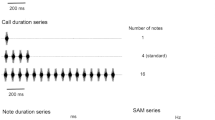Abstract
Acoustic communication is an important behavior in frog courtship. Male and female frogs of most species, except the concave-eared torrent frog Odorrana tormota, have largely similar audiograms. The large odorous frogs (Odorrana graminea) are sympatric with O. tormota, but have no ear canals. The difference in hearing between two sexes of the frog is unknown. We recorded auditory evoked near-field potentials and single-unit responses from the auditory midbrain (the torus semicircularis) to determine auditory frequency sensitivity and threshold. The results show that males have the upper frequency limit at 24 kHz and females have the upper limit at 16 kHz. The more sensitive frequency range is 3–15 kHz for males and 1–8 kHz for females. Males have the minimum threshold at 11 kHz (58 dB SPL), higher about 5 dB than that at 3 kHz for females. The best excitatory frequencies of single units are mostly between 3 and 5 kHz in females and at 7–8 kHz in males. The underlying mechanism of auditory sexual differences is discussed.




Similar content being viewed by others
Abbreviations
- AENFP:
-
Auditory evoked near-field potential
- BEF:
-
Best excitatory frequency
- CF:
-
Characteristic frequency
- RMS:
-
Root mean square
- SPL:
-
Sound pressure level
- TS:
-
Torus semicircularis
References
Arch VS, Grafe TU, Narins PM (2008) Ultrasonic signalling by a Bornean frog. Biol Lett 4:19–22
Arch VS, Grafe TU, Gridi-Papp M, Narins PM (2009) Pure ultrasonic communication in an endemic Bornean frog. PLoS One 4:e5413
Arch VS, Burmeister SS, Feng AS, Shen J-X, Narins PM (2011) Ultrasound-evoked immediate early gene expression in the brainstem of the Chinese torrent frog, Odorrana tormota. J Comp Physiol A 197:667–675
Capranica RR, Moffat AJM (1983) Neuroethological correlates of sound communication in anurans. In: Ewert JP, Capranica RR, Ingle DJ (eds) Advances in vertebrate neuroethology. Plenum, New York, pp 701–730
Fei L, Hu SQ, Ye CY, Huang YZ et al (2009) Fauna Sinica. Amphibia vol. 3, Anura Ranidae. Science Press, Beijing, pp 1219–1224
Feng AS, Narins PM, Xu CH, Lin WY, Yu ZL, Qiu Q, Xu ZM, Shen JX (2006) Ultrasonic communication in frogs. Nature 440:333–336
Gridi-Papp M, Feng AS, Shen JX, Yu ZL, Rosowski JJ, Narins PM (2008) Active control of ultrasonic hearing in frogs. Proc Natl Acad Sci USA 105:11013–11018
Hetherington TE (1994) Sexual differences in the tympanic frequency responses of the American bullfrog (Rana catesbeiana). J Acoust Soc Am 96:1186–1188
Mason MJ, Lin CC, Narins PM (2003) Sex differences in the middle ear of the bullfrog (Rana catesbeiana). Brain Behav Evol 61:91–101
McClelland BE, Wilczynski W, Rand AS (1997) Sexual dimorphism and species differences in the neurophysiology and morphology of the acoustic communication system of two neotropical hylids. J Comp Physiol A 180:451–462
Narins PM, Capranica RR (1976) Sexual differences in the auditory system of the tree frog Eleutherodactylus coqui. Science 192:378–380
Narins PM, Feng AS, Lin WY, Schnitzler HU, Denzinger A, Suthers RA, Xu CH (2004) Old World frog and bird vocalizations contain prominent ultrasonic harmonics. J Acoust Soc Am 115:910–913
Shen JX, Xu ZM, Yu ZL, Wang S, Zheng DZ, Fan SC (2011a) Ultrasonic frogs show extraordinary sex differences in auditory frequency sensitivity. Nat Commun 2:342
Shen JX, Xu ZM, Feng AS, Narins PM (2011b) Large odorous frogs (Odorrana graminea) produce ultrasonic calls. J Comp Physiol A 197:1027–1030
Yu ZL, Qiu Q, Xu ZM, Shen JX (2006) Auditory response characteristics of the piebald odorous frog and their implications. J Comp Physiol A 192:801–806
Zelick R, Mann DA, Popper AN (1999) Acoustic communication in fishes and frogs. In: Fay RR, Popper AN (eds) Comparative hearing: fish and amphibians. Springer, New York, pp 363–411
Acknowledgments
This work was supported by the grants from the National Natural Science Foundation of China (No. 30730029 to J.X.S.; Nos. 31070741 and 31270891 to Z.Q.). All experiments were conducted following the Animal Care and Use Guidelines approved by the Institute of Biophysics, Chinese Academy of Sciences.
Author information
Authors and Affiliations
Corresponding author
Rights and permissions
About this article
Cite this article
Liu, WR., Shen, JX., Zhang, YJ. et al. Auditory sexual difference in the large odorous frog Odorrana graminea . J Comp Physiol A 200, 311–316 (2014). https://doi.org/10.1007/s00359-014-0885-3
Received:
Revised:
Accepted:
Published:
Issue Date:
DOI: https://doi.org/10.1007/s00359-014-0885-3




